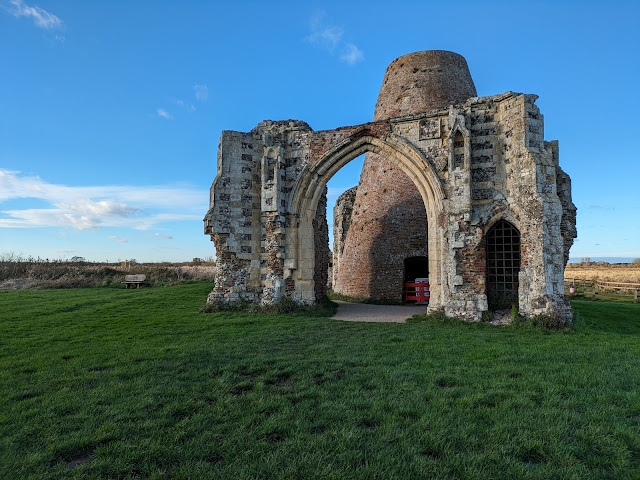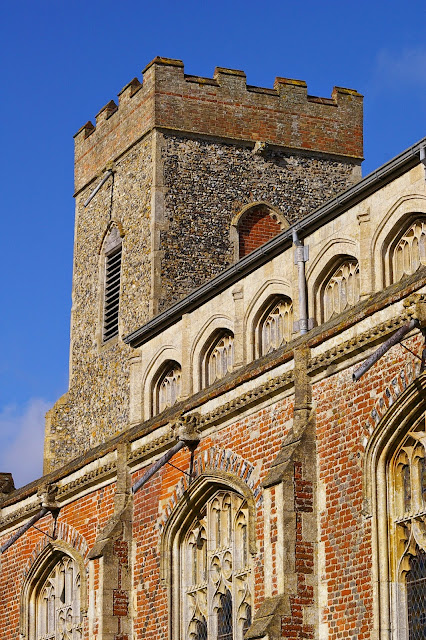I was not a happy! It was the Sunday before Blue Monday! The most depressing day of the year! Over 89,000 had died from Covid 19. Intensive care wards were full to overflowing! Staff were exhausted and running on empty!
I was not H-A-P-P-Y! I knew I wasn't! I was sure I wasn't! HappyClappy choruses seemed completely empty - completely devoid of meaning!
My path took me through the village, past the silent tower of Coltishall Church. Bells have not rung here since March. Once again the ringing chamber was empty of ringers! The church empty of worshippers! And on the west front, the two plinths that once supported the statues of saints were empty too!
I made my wayover the bridge to All Saints', Horstead. In normal times, services alternate between Coltishall and Horstead, but on this Sunday both churches were empty! Worship had migrated online! Still, I walked the miles, "to kneel where prayer has been valid" and to show solidarity with past generations.
At the west end of Horstead Church, at the base of the tower, there is a niche that one housed an image. Yes, it is empty!
(You might have noticed an "Empty" theme developing.)
Empty, yes! But I find meaning in the emptyness!
Our pandemic is a disrupter, when it is all over things will not be the same! Yet it's small beer to some disrupters the Church has known.
Back in 1349, between half and two-thirds of the population died in the first wave of the Black Death. It was a plague that returned time and again, until it petered out sometime after 1665. By which time another disrupter had shaken the Church!
Those were times of full churchyards, empty pews and much heart searching. What did it all mean? Some thought it was God's judgement! But that didn't quite work. You couldn't help noticing that the least sinful and the most sinful suffered unequally. The least sinful - the key workers of the day - caring for the sick and burying the dead, were suffering and dying more than the most sinful, who were to a man and woman, trying very hard to keep safe and not helping at all!
The experience of that pandemic, turned people's minds to God and it was a great time of church building and beautification. Horstead and Colitishall's church towers both date from those days. It was also a time of new technology and new ideas. The printing press had increased the number of books in circulation. More people were learning to read and write. Among the new ideas were religious movements that culminated in profound changes to the Church. The great disruption we call the Reformation!
The Reformation wasn't good for pilgrimages. They were supressed in 1521! And it wasn't good for images in church either, wall paintings were painted over and statues broken up.
Coltishall's empty plinths probably supported images of the church's patrons, the two St. Johns, the Baptist and the Gospel Writer. It was more difficult to work out who the occupant of Horstead's empty niche might have been. Some detective work was called for.
The best clue I've found is the will of Alice Cook, who died in 1478. She left a sum of money for someone to go on pilgrimage for her to "Our Lady of Pity at Horstead". I like like the idea, that Horstead had its own Pieta/Our Lady of Pity! You couldn't find a more appropriate place for Our Lady of Pity than a niche, overlooking a churchyard in which so many plague victims were buried!
Today, the best known image of the Pieta is the Michaelangelo in St. Peter's Basilica in Rome. Mary is seen holding her son, the dead Christ, in her lap. Soon she will wrap him in grave clothes and lay him in the cave of his tomb; just as she swaddled her new born, in the stable cave of his birth so long ago. In days of plague, at a time when many a mother buried her children, this image spoke loudly!
Not of Judgement, but of "God with us". A merciful God, with us in all the suffering. God with us in the care of neighbour - "In as much as you did it to any of these little ones, you did it to me. " (Matthew 25.40) God with us, with a promise, "that as in Adam all die; even so in Christ shall be made alive." (1 Cor. 15.22)
One Norfolk carving of Our Lady of Pity survived. You can find it on the, 1408, font, in Acle Church.
Unfortunately, heads were damaged before the carving was covered over at the Reformation; and replaced, when the carvings were discovered and restored in Victorian times. Maybe it is not quite as life like as the Michaelangelo, but the Acle image carries some additional layers of meaning. The size of the Christ figure, is a reminder of the infant as well as the man; and the linen, more evident in the picture below, suggests a link with Holy Communion, "the "Body of Christ, given for you".
It was a common image everywhere in 14th and 15th Centuries. Here is from a 15th Century Dutch Book of Hours
Here's a contemporary poem translated from the Old English
O all women that ever were born
That bear children, stay and see
How my son lies me before
Upon my knee, taken from the tree.
Your children you dance upon your knee
With laughing, kissing, and merry cheer:
Behold my child, behold now me,
For now lies dead my dear son, dear.
Many a mother buried her children in those days; and the messy practicalities of birth, death, sickness, clean linen and dirty washing were mainly women's work. Some might say, 'No change there, then!'
Our pandemic is disrupter too! Things will never be the same!
It coincides with an additional disruption. One that was already underway when Covid struck, the digital revolution! Just as the advent of the printing press brought profound changes, so too the digital revolution is midwife to an unknown, unfolding future.
Alice Cook and I and Michaelangelo, and the anonymous carvers of Horstead and Acle's images, would like my readers know that "God is the same, yesterday, today and tomorrow".









Comments